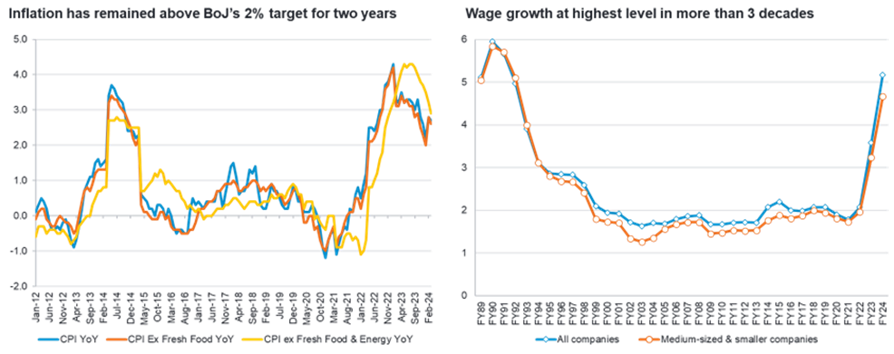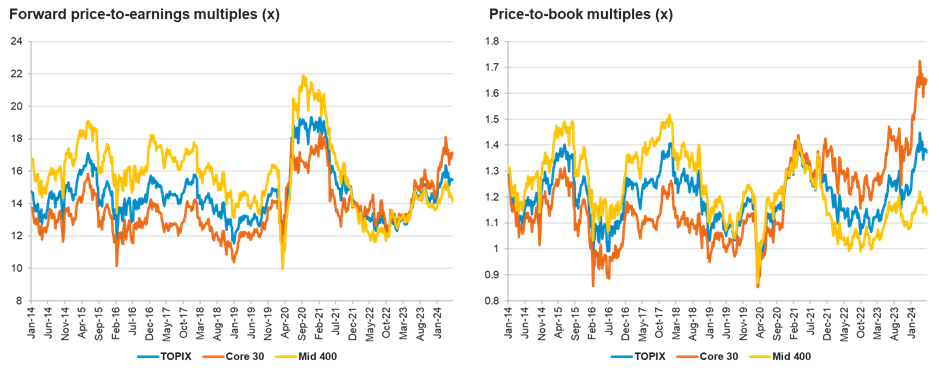Why Japan’s mid-caps could follow their large-cap peers
The recent strength of Japanese equities has been underpinned by several key factors, particularly the country’s shift towards moderate inflation and corporate governance reforms. Larger companies have so far led the rally, but Fidelity Japan Trust PLC (LON:FJV) Nicholas Price sees strong potential for mid and small-caps to catch up. He highlights the overlooked opportunities in this under-researched segment.
In Japan, the core Consumer Price Index (CPI) has been above the Bank of Japan’s (BoJ) 2% target for around two years and, in March, the central bank ended eight years of negative interest rates. Initial imported inflation has waned, and we are seeing stickier domestic inflation take hold, with services inflation in April reaching a near 10-year high of +2.8%.
Moreover, Japanese companies are raising wages at the highest rate since the 1990s, reflecting a combination of tight labour markets, balance sheet strength and political pressure.

Source: Fidelity International, (1) Ministry of Finance as of 31 March 2024, (2) The Japanese Trade Union Confederation as of 8 May 2024.
This new inflationary backdrop is creating a range of attractive investment opportunities in Japanese businesses – often among mid and small-caps that are closely tied to the domestic economy that can expand their profit margins. Indeed, we have seen stock rallies in some companies that have successfully raised prices and increased margins and there could be more of these stories if reflation is sustained.
TSE reforms are also unlocking value
In March 2023, the Tokyo Stock Exchange (TSE) requested that all listed companies on the Prime and Standard markets (c.3,200 companies) disclose measures to implement management that is conscious of the cost of capital and stock prices. From January 2024, the TSE started publishing a list of companies that have disclosed information in accordance with its request, thereby encouraging corporates to take a more proactive approach.
So far, the highest disclosure rates have been concentrated in large-cap, low price-to-book companies in sectors such as banks, shipping, utilities and commodities. However, the TSE-led reforms are broadening out across the market, and we are seeing growth and mid-cap companies become more active in terms of shareholder returns. Given that mid and small caps have a large presence in terms of absolute numbers and that a high proportion trade below book value, there is significant scope for change.
The underappreciated opportunity in mid and small caps
The market rally in Japan has been driven predominantly by large caps. Since the start of 2023, the TOPIX Core 30 Index has returned around 30% in sterling terms versus far more muted returns for the TOPIX Mid 400 and Small indices. Notably, mid and small-cap growth stocks have faced significant style headwinds in the face of the US Federal Reserve’s hiking cycle.
12 month rolling returns net of fees, GBP %
| 31.05.19 – 31.05.20 | 31.05.20 – 31.05.21 | 31.05.21 – 31.05.22 | 31.05.22 – 31.05.23 | 31.05.23 – 31.05.24 | |
| TOPIX Total Return Index | 9.5% | 7.3% | -2.4% | 7.3% | 15.2% |
| TOPIX CORE 30 Index | 11.4% | 9.9% | 1.6% | 7.8% | 22.0% |
| TOPIX Mid 400 Index | 9.6% | 4.9% | -6.2% | 7.1% | 7.4% |
| TOPIX Small Index | 9.3% | -0.4% | -3.5% | 7.5% | 9.9% |
Past performance is not a guide to the future.
Source: Fidelity International and TOPIX, as of 31 May 2024. Performance basis: Bid to bid with income reinvested in GBP terms, net of fees rounded off to two decimal places.
As the Fed appears to be moving closer to a reversal in monetary policy, the outlook for mid and small-caps in Japan should start to improve. And, as the following charts show, from a valuation perspective, Japanese mid-caps are trading at a steep price-to-book (PB) discount to the larger-cap indices and have lost the price-to-earnings (PE) premium that was a constant feature of the past decade or so.

Source: Fidelity International, Bloomberg, 24 May 2024.
Although mid and small-caps account for around 90% of the TOPIX universe, they are often overlooked or under researched. Most smaller companies have little or no street coverage and around 60% of mid-caps have very limited analyst coverage. This level of market inefficiency can create extreme mispricing. And as an active manager on the ground who meets a lot of companies, this dynamic creates a wealth of untapped and differentiated investment opportunities among both domestic and export-related firms.
A prime example is Osaka Soda, an under researched small-cap stock that is transforming from a basic chemicals company to a supplier of value-added functional and healthcare materials. We initiated a position in the stock in mid-2022 when it had a market cap below £500 million (since which it has more than doubled) and was only covered by local brokers who cater to individual investors.
This lack of street coverage belies the fact that Osaka Soda is the monopoly supplier of high-grade silica gel, a high-margin purification material that is key to the production of GLP-1 and insulin drugs. With GLP1 drugs expanding into obesity treatments, it is well positioned to meet the rapid demand growth from global pharmaceuticals companies. Finally, its net cash balance sheet offers scope for higher shareholder returns.
Structural factors bode well for Japanese stocks
We believe that Japan’s shift to moderate inflation and its impact on spending and investment decisions by households and corporates, combined with steady progress in governance reforms, represent multi-year structural trends.
Japanese equities traded on a forward price-to-earnings multiple north of 50x during the bubble period, so the current multiple of around 15x does not look expensive historically nor relative to other markets, especially considering current interest rates. Moreover, a sustained improvement in returns on equity would support a higher price-to-book multiple, and the economic trend towards moderate inflation supports higher earnings-based valuations.
Although we have seen renewed buying of Japanese stocks by overseas investors since March 2023, cumulative net flows remain well below the 2015 peak witnessed during the era of ‘Abenomics’ and global active funds remain underweight. Japanese households are also relatively underweight equities when it comes to their mix of financial assets.
These significant structural underweights in investor portfolios suggest there is ample room for inflows into Japan’s markets. If the corporate sector, guided by more shareholder-friendly policymaking, can continue to build on its success in recent years in boosting returns, then inflows could persist.
Important information
The value of investments and the income from them can go down as well as up, so you may get back less than you invest. Past performance is not a reliable indicator of future returns. Fidelity Japan Trust PLC invests more heavily than others in smaller companies, which can carry a higher risk because their share prices may be more volatile than those of larger companies and the securities are often less liquid. Changes in currency exchange rates may affect the value of investments in overseas markets. The shares in the investment trust are listed on the London Stock Exchange and their price is affected by supply and demand. This investment trust can gain additional exposure to the market, known as gearing, potentially increasing volatility. Reference to specific securities should not be construed as a recommendation to buy or sell these securities and is included for the purposes of illustration only. This information is not a personal recommendation for any particular investment. If you are unsure about the suitability of an investment you should speak to an authorised financial adviser. Investors should note that the views expressed may no longer be current and may have already been acted upon
The latest annual reports, key information document (KID) and factsheets can be obtained from our website at www.fidelity.co.uk/its or by calling 0800 41 41 10. The full prospectus may also be obtained from Fidelity. The Alternative Investment Fund Manager (AIFM) of Fidelity Investment Trusts is FIL Investment Services (UK) Limited. Issued by FIL Investment Services (UK) Limited, authorised and regulated by the Financial Conduct Authority. Fidelity, Fidelity International, the Fidelity International logo and F symbol are trademarks of FIL Limited. UKM0724/387964/ISSCSOXXXX/NA
Fidelity Japan Trust plc aims to be the key investment of choice for those seeking Japanese companies exposure. The Trust has a ‘growth at reasonable price’ (GARP) investment style and approach – which involves identifying companies whose growth prospects are being under-appreciated or are not fully recognised by other investors.



































